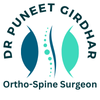Navigation Guided Spine Surgery in Dehi
Enables faster, more precise and less invasive spinal procedures in a reduced radiation environment
Having GPS on your smartphone or in your car has probably changed the way you get from place to place. Similar to what GPS has done for geographic navigation, 3D image-guided surgery has revolutionized spine surgery.
Medtronic invests in technologies like 3D image-guided surgery to continue to improve spinal procedures. The O-arm surgical imaging system and Stealth Station surgical guidance system work together to help your surgeon plan for, and conduct surgery with less invasive procedures.

Stealth Station Surgical Navigation System
The Stealth Station® surgical navigation system is like your personal computer—it’s a combination of hardware and software. Surgical planning software helps surgeons get ready for surgery before ever making an incision. Monitors and displays help surgeons see exactly where their surgical instruments are in relation to the spine throughout a procedure.
O-arm Surgical Imaging System
The O-arm® surgical imaging system takes pictures and provides an inside view of what’s happening with your spine before and during surgery. The O-arm® system is different from a traditional x-ray machine or CT scanner because it can provide real-time and high-quality images in two or three dimensions, and a detailed look at your anatomy—from head to toe, even during surgery.
The amount of radiation emitted during an O-arm system scan is less than a CT scan and well within the range permitted by regulating bodies. Please talk to your surgeon before your procedure to have all of your radiation exposure questions answered.
Benefits of Surgery With Stealth Station ® Surgical Navigation and O-arm ® Surgical Imaging Systems
These two technologies are designed to work together to help your surgeon:
- Prepare for surgery, including how to best get to the targeted area before ever stepping into the operating room
- Reduce procedure invasiveness and risk
- Make more informed decisions during surgery
- Precisely navigate through delicate anatomy and avoid critical structures in the spine
These sophisticated tools aren’t yet available in every hospital specializing in spinal surgeries. However, Medtronic is working toward that goal. Ask your surgeon about 3D image-guided surgery.
Potential Risks
Potential risks to any surgical procedure include unforeseeable complications caused by anesthesia, blood clots, undiagnosed medical problems such as silent heart disease, and rare allergic reactions. Complications of spinal surgery can include neurological damage, paralysis, damage to the surrounding soft tissue and, where used, instrument malfunction. Most of these complications can be treated once they are detected, but sometimes they require a longer period of hospitalization or recovery, additional medications, and sometimes even additional surgery. Depending upon the type of surgery you are having, these risks will be explained by the primary surgeon. Other risks associated with implants used include device migration, loss of spinal curvature, correction, height, and/or reduction.
3D IMAGE GUIDED SPINE SURGERY
3D image guided spine surgery is kind of like GPS for your back, and it’s revolutionizing how spinal procedures are performed.
If you are considering spine surgery, know that there’s never been a better time to undergo this procedure. That’s because surgical imaging and navigation technologies enable your surgeon with accuracy and enhanced visualization both before and during surgery.
- Before surgery – Surgical planning software can help surgeons prepare for the patient’s procedure
- During surgery – Intraoperative imaging provides a detailed view of the patient’s anatomy in real time
What is Surgical Imaging and Navigation?
Using intraoperative scans and a technology similar to GPS, the Stealth Station ® surgical guidance system allows surgeons to visualize the patient’s anatomy in 3D and the placement of surgical instrumentation throughout the procedure.
What Are the Benefits of Surgical Imaging and Navigation?
Surgery with the O-arm ® Imaging System and navigation technology may enable your surgeon to:
- Accurately navigate through the delicate anatomy and avoid critical structures in the spine
- Perform a more minimally invasive procedure
- Preserve healthy anatomy during surgery
O-arm intraoperative images:
- Help physicians make better decisions during surgery
- Provide surgeons with high-definition, real-time images before, during, and post procedure
These sophisticated tools are not yet available in every hospital specializing in spinal surgeries. However, Medtronic is working toward that goal. Ask your surgeon about 3D image guided surgery.
